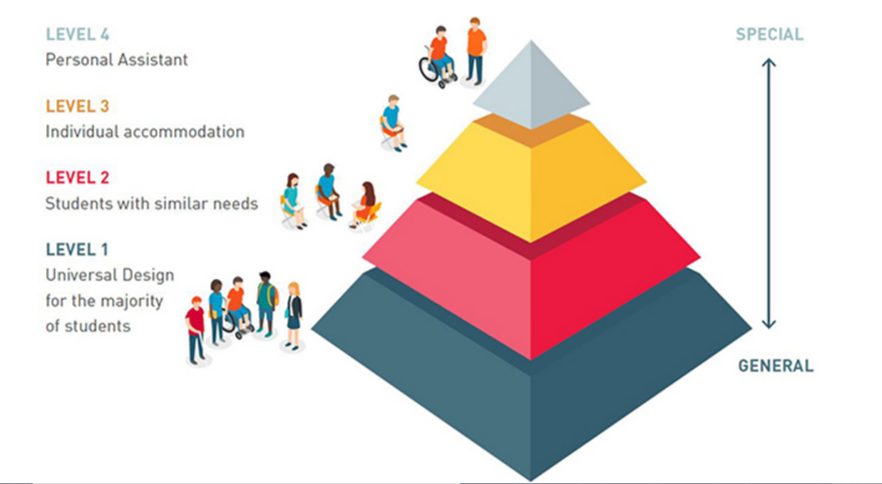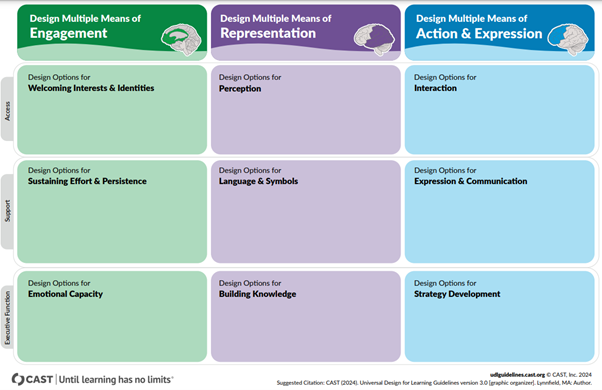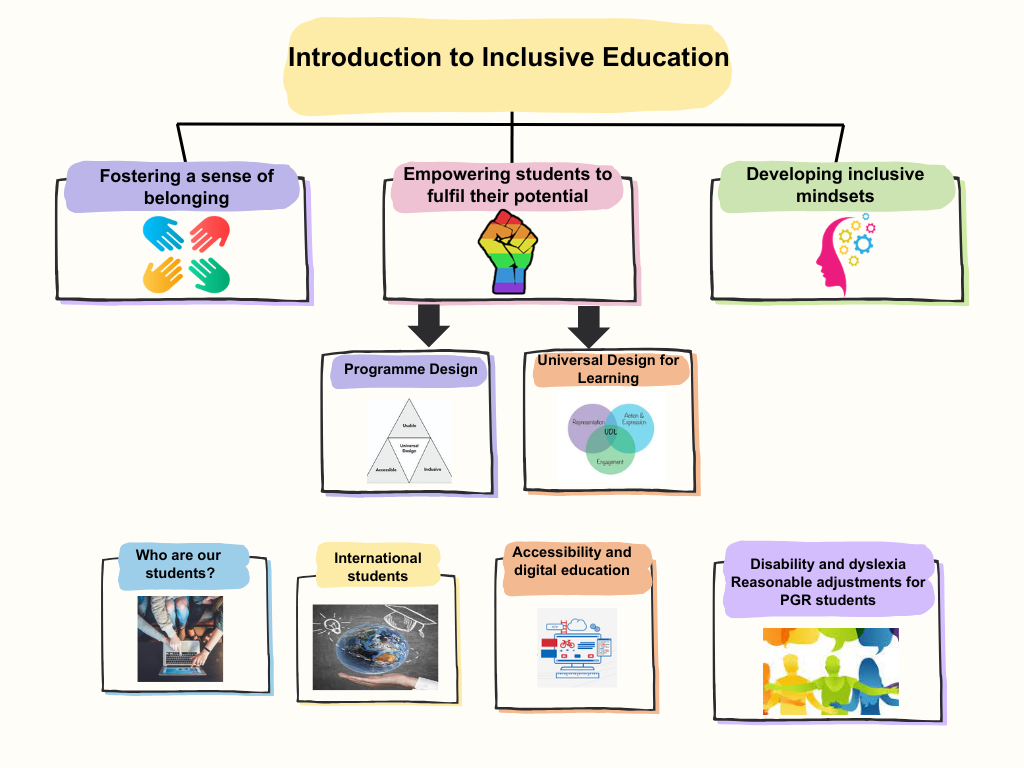Reasonable Adjustments
Supporting Disabled Students in Cardiff University: Legislation, Policy and Practice
Higher Education Institutions have a duty under the Equality Act 2010 to prevent discrimination, harassment, and victimisation. A recent large scale research report identified that only 36% of students who have had any support approved by their university have all that support put in place (Disabled Students UK 2023).
Where it might put disabled students at a substantial disadvantage, we have a legal duty to existing students, applicants, and former students to make reasonable adjustments to:
- provision, criterion or practice
- physical features of the building or premises and
- information, to ensure it is provided in an accessible format.
The duty is anticipatory and continuing, regardless of whether you know that a particular student is disabled or whether you currently have any disabled students. You should not wait until an individual disabled student approaches you before you consider how to meet the duty (EHRC 2014).
There are therefore two approaches to meeting the needs of disabled students:
A. Inclusive Learning and Teaching
B. The legal obligation to meet identified Reasonable Adjustments for individual disabled students.
A. Inclusive Learning and Teaching
Inclusive education requires a continuum of supports that reaches from the classroom to support services, and which incorporates the provision of reasonable adjustments. We need to consider firstly the bottom layer, our universal design of teaching, and then our signposting and interaction with the higher levels.

Figure: UDL and the Continuum of Supports (AHEAD 2023)
LEVEL 1: THE MAJORITY OF STUDENTS: With the incorporation of inclusive education principles into the mainstream practice of the institution, the majority of students can have a successful learning experience without additional support.
LEVEL 2: STUDENTS WITH SIMILAR NEEDS: In some cases, students with similar needs who required additional support can have support provided in a group setting. Examples of this would include group learning support sessions for mature students, and examinations in alternative venues for students needing extra time or a quiet environment.
LEVEL 3: INDIVIDUAL ACCOMMODATION: Individual accommodations or adjustments remain a very important part of an inclusive institution. Some students require individual supports such as Assistive Technology or flexibility with examination deadlines which enable them to participate fully in the learning experience.
LEVEL 4: PERSONAL ASSISTANT: Sometimes students might have the need for more personal, professional supports, in addition to individual accommodations like those outlined in Level 3. For example, students with certain disabilities may require the use of a personal assistant on campus, or, in an exam setting, a reader or scribe.
So what can you do? Inclusive Practice
Start with inclusive, universal design: what can you do to make changes to your practice that are available to all students?
Whilst reasonable adjustments are a legal obligation under the Equality Act, using inclusive approaches benefits all. For example:
- providing all resources such as PowerPoints, documents or readings 48 hours in advance may be a reasonable adjustment for a student with dyslexia, but will also help those with English as an additional language
- providing recordings of the session may be a reasonable adjustment for students with a condition causing problems with note-taking or attendance due to disability, but will also support those who cannot attend due to short- or long-term health conditions, and those with caring responsibilities or employment.
Using inclusive approaches for the whole cohort also benefits us: where we provide universally, less time is taken in the administration of individual requirements, and the crisis-management of individual issues.
Cardiff University Reasonable Adjustments
Take a look at this snapshot of Cardiff University reasonable adjustments from December 2022
If we follow just these five core practices for inclusive education, our numbers of reasonable adjustments would be significantly reduced!
Top Tips: Five Core Practices for Inclusive Education:
- Provide all resources for the session 48 hours in advance via Ultra, including PowerPoints and documents
- Record all lectures, and enable students to audio record sessions.
- For seminars or other active sessions, provide notes in Ultra, or ask students to summarise discussions or activities.
- Provide coherent reading lists which are accessible in advance, have literature easily available online or in Ultra, and which indicate which are essential, desirable and ‘other’ readings
- Be aware that some of your students will have medical needs which may mean they may not be able to attend, or may need to leave sessions early
When considering making our practice inclusive, we could use the approach of Universal Design for Learning (UDL), which creates a learning environment designed for a diversity of learners, rather than retrospectively making adaptations to accommodate specific students. UDL builds flexibility in the core curriculum through multiple means of representation, action and expression and engagement.

Figure: Universal Design for Learning (CAST 2024)
You can read more about Universal Design for Learning on this toolkit page
Try this exercise to develop your skills in designing for inclusive practice, before clicking to reveal the model answer below.
Model Answer (click to reveal)
Teaching Guidance Document for all staff teaching on Module X
To meet the needs of our students we need to consistently design and deliver our teaching inclusively, being responsive to identified reasonable adjustments. Please follow this guidance to ensure we meet our responsibilities.
Learning materials and resources
- Make all PowerPoints or other visual aids, reading materials or any other information available at least 48 hours in advance of the sessions to all students.
- Record your session and upload as soon as possible to the Ultra page, under the section for the session, for all students. If this is not possible, for example in seminars or labs, provide notes or ask students to provide summaries, and upload after the session
- Provide a targeted reading list for each session before the module commences, ensuring the texts are available in the library, online where possible: 1-2 short essential readings, plus recommended and extended readings.
- In Ultra, use a range of formats for information: for example provide a short video summary of texts, or link to YouTube or podcasts or other audio material (to provide multiple means of representation)
Guidance for Delivery of Teaching
- Be aware of engagement: design your session with 15-20 minute segments followed by a change in activity. Allow 1 minute silent thinking times. Give choice of topic, and offer variety in mode of responses from student activities (for example, feedback to the group orally, or type your answer into mentimeter) ( to provide multiple means of engagement)
- At the beginning establish ground rules: that you welcome audio recording; that questions can be posted on a mentimeter, or saved for the end of the session; that students are free to move around or leave if necessary but please keep disruption to a minimum; that discussions should respect opinion and diversity.
- Give a session outline or timetable
- Be aware that one student may arrive late to the session, and requires a wheelchair space: contact me if there are challenges and I will contact time-tabling. Organise the students so that they can work in groups – do not leave this student isolated at the front.
Assessment
- Whether your assessments are formative or summative, ensure that you and the marking team are aware of those students who have reasonable adjustments for disabilities affecting expression, and that you discount criteria for expression in your marks, as this is not a core competence for this module. See the Reasonable Adjustments: Guidance for Teaching staff on this page for more detail.
- Provide options for topic, task or mode (to provide multiple means of engagement).
- In your feedback, whether written or verbal, be conscious of your language and ensure your comments reflect the learning outcomes, marking criteria and/or guidance for the task (to provide multiple means of action and expression).
B. Reasonable Adjustments
Whilst inclusive practice can meet the learning needs of a large number of students, there will always be some changes to practice that are required to meet the unique specific needs of individual disabled students. For example, access to recordings of lectures is the most common reasonable adjustment, and therefore if this is available to all students, a number of diverse students will benefit, and a great deal of work is saved in administration. Providing paper handouts in large print, however, would only be required if you had a visually impaired student in the cohort.
Making reasonable adjustments to teaching practice, and to the organisation of programmes and assessments, is a legal obligation under the Equality Act 2010. You can find more detail on the Reasonable Adjustment Policy intranet page, which has links to the policy, guidance on inclusive practice and reasonable adjustments for teaching Staff, and those who work with postgraduate research students, and further information.
If you want to learn more, you can sign up for our CPD workshops: Disability, Dyslexia and Inclusive Education; Disability and Reasonable Adjustments for PGR students; Accessibility and Digital Education; and an Introduction to Inclusive Education.
You can also visit our drop-in sessions, if you have questions or queries about the policy, reasonable adjustments in general, or inclusive practice for disabled students.
What support is available for disabled students in Cardiff University?
In addition to ensuring your design, teaching and support of students meets their needs and reasonable adjustments, you may want to support students to access the wealth of services available from the Student Life teams. If you are unsure which service may be of benefit, recommend the student visit the Student Connect team, online or in the Centre for Student Life, who will ensure they reach the correct services.
- Assessment for Disabled Students Allowance (benefit which may fund equipment, increased general allowances, or non-medical support)
- Assessment of learning need and some forms of screening (for example, for specific learning difficulties such as dyslexia)
- Study skills tutors, and specialist tutors (eg for autistic students)
- Student mentoring and peer support
- Access arrangements and reasonable adjustments
- Wellbeing support and Counselling services
- Student Connect Team: one-stop hub for all student needs, based in the Centre for Student Life
Where Next?
Map of Topics
Below is a map of the toolkit and workshop topics, to aid your navigation. These will be developed and added to in future iterations of this toolkit:

You’re on page 8 of 9 Inclusivity theme pages. Explore the others here:
Inclusivity and the CU Inclusive Education Framework
Introduction to Inclusive education
Fostering a sense of belonging
Empowering students to fulfil their potential